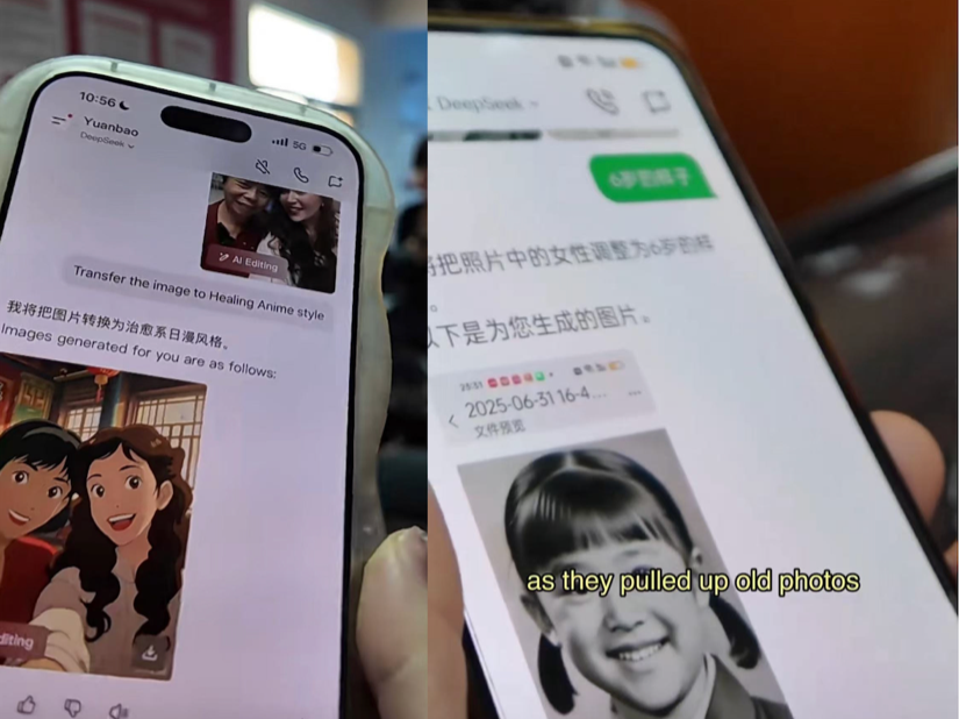Seniors in Sha Xian country using Yuanbao’s translation function to make foreigner friends while preserving old memories.
A weibo user
In community centers across rural Sha Xian County in Fujian province, the familiar clack of mahjong tiles now mingles with something far less traditional: seniors huddled around smartphones, learning the intricacies of artificial intelligence.
Videos of grandparents using AI to identify plants, cook new dishes, and write playful love letters have garnered millions of views on Chinese social media. But these classes are more than mere amusement. They’re teaching practical skills: how to use AI assistants to navigate healthcare, manage mobile payments, and avoid scams that prey on older citizens.
The sight of retirees engaging directly with AI is striking proof of a larger phenomenon. While U.S. tech giants chase breakthroughs in artificial general intelligence (AGI) behind closed doors, China is actively weaving technology into the everyday lives of people often excluded from digital revolutions.
As the world grapples with an unprecedented aging population, Chinese tech giants turning their focus to the elderly could provide real, workable solutions to the looming demographic crisis – and offer a compelling blueprint for the rest of the world.
Why seniors are the first battleground
At first glance, the strategy might look like simple math. China is home to more than 280 million people over 60 – a number expected to soar as birth rates fall and life expectancy rises. This ‘silver economy’ represents trillions of yuan in untapped value.
But the deeper reason lies in positioning. By engaging seniors, the government and major tech firms signal that inclusivity is not an afterthought but a long-term principle guiding AI adoption. In a society where intergenerational care has deep cultural roots, empowering older adults resonates both economically and morally.
Fraud prevention has emerged as a core motivator. Older adults are frequent targets of digital scams, from fake investment schemes to phishing attempts. That is why many AI training programs for seniors begin with lessons on scam recognition. Voice-enabled AI assistants like Tencent’s Yuanbao or Ant Finance’s elder-friendly Alipay not only simplify digital interactions but also act as guardians, flagging suspicious activity and creating safer online environments.
Beyond seniors: AI for the underserved
While seniors are a focal point, they are far from the only beneficiaries. China’s AI push deliberately targets multiple underserved groups. Rural residents, low-income workers, and digitally inexperienced users are being brought into the fold.
Smartphone use among these demographics are surprisingly high, yet, many people still lack reliable access to healthcare, banking, or government services. AI is filling these gaps. From simplified telemedicine platforms to financial literacy tools, underserved users are gaining access to services previously confined to cities.
This broad inclusivity strategy reflects a different vision of AI’s purpose. Rather than treating advanced technology as a luxury, China is embedding it as a necessity for ordinary life. The emphasis is not on how smart the system is, but who benefits from it.
Silicon Valley vs. Sha Xian County
The contrast with the United States and Europe is sharp. In Silicon Valley, the energy and investment around AI are overwhelmingly concentrated on pushing technical frontiers. The race toward AGI – systems that could theoretically rival human intelligence – dominates research labs and venture capital. Products reaching the market tend to cater to younger, digitally fluent consumers: entertainment platforms, productivity apps, and e-commerce engines.
Outside of China, much of the AI and tech ecosystem targets younger, digitally native consumers, prioritizing entertainment, e-commerce and academic tools. Elderly care also tends to be addressed as a health service rather than a set of multiple problems with a range of potential technological fixes.
Governance also plays a part. Elderly friendly interfaces on apps, for example, are a direct result of a 2020 Chinese State Council directive. Ambitions to open the world of embodied AI to elderly care reflect directives in a Five-Year Plan to do so. In other countries, where tech tends to follow market forces more than it does government directives, technology moves in the direction the engaged – and usually young – consumers drive it.
From anxiety to empowerment
China’s approach also addresses a subtle but critical issue: public anxiety about AI. Around the world, many people fear that rapid technological change will leave them irrelevant or excluded. By bringing seniors, the group most at risk of exclusion, into the AI ecosystem, China is reshaping that narrative.
For a retiree in Sha Xian County, learning to ask an AI assistant to check a medical appointment is more than a digital convenience. It signals that technology is not something foreign, hostile, or only for the young. It is a bridge to independence, dignity, and continued participation in modern life. This framing turns AI from a source of anxiety into a source of empowerment.
In the West, Chinese tech giants are often portrayed as cold, profit-driven behemoths. Yet these inclusive AI strategies complicate that image. Yes, the ‘silver economy’ represents a lucrative growth frontier, but companies are cultivating it through features that actively solve serious social problems: fraud protection, accessible finance, rural service delivery. With wide benefits beyond profit, it’s becoming harder and harder for naysayers to malign Chinese big tech for a lack of CSR.
Innovation With Dignity
In Sha Xian County, the elderly students finishing their AI class might not know much about AGI or the global race to build smarter machines. But they know how to use voice commands to call family, how to pay safely with their phones, and how to spot a scam before it harms them.
That simple empowerment tells a bigger story. While the someone looks to the future of machines, others are looking to people, ensuring that no one, young or old, urban or rural, is left behind.
The result is a model of innovation with dignity: technology that doesn’t just advance, but includes. And in a world growing older by the day, that lesson may be just as important as any technical breakthrough.









